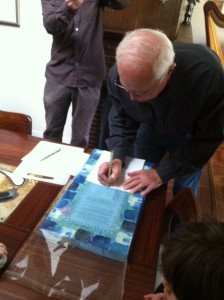
It seems everyone is writing their New Year’s posts, declaring their alternatives to New Year’s resolutions, announcing their Theme Word For The Year, etc, but it’s going to take awhile for me to do my usual end-of-year/start-of-year processing.
Let’s face it, New Year’s Eve was pretty much eclipsed for me by the fact that I got married on Saturday, three days before.
No last night of the year partying for me. Miracle Man and I spent a quiet evening at home on the 31st, curled up in bed watching a movie.
In fact, the movie we watched was the video of our wedding ceremony. And we laughed and got all choked up for the nth time.
Yes, we are romantic dorks. 🙂
(Did you see the video of the song I wrote and sang for Miracle Man as part of the ceremony? If not, click here. But then come back to see the rest of the ketubah-making saga. Though you may want to read part 1 and part 2 first.)
There was some doubt in some circles about whether I’d finish the ketubah in time for the wedding. Ahem. Yes. Well, I did finish it, and this post is a documentary of that process.
I want to say first, though, that I’m still really tickled by how much fun I had, and what a difference creating this wedding was from my creating my first wedding.
Twenty years ago, the first time around on the wedding-planning carousel, the theme was perfection.
As in, “if the wedding is perfect, maybe my life will be good.”
As in, “if the wedding is perfect, maybe my marriage will be okay.”
If this had been true, of course, I wouldn’t now refer to that marriage as my “practice marriage,” and there would have been no wedding #2 on Saturday.
When I planned my first wedding, I did not yet think of myself as an artist. The idea that I might make my own ketubah, or heaven forbid write a song for my beloved, those were not even on the radar of “someday” possibilities at that point.
Instead, I hired creative talent. I acted as the curator — which was certainly a creative act, don’t get me wrong — but I was way more concerned about beauty and perfection than about having fun.
Really, much as I hate to admit it, I think my first wedding was about wanting to impress more than anything else.
This time around it was about wanting to have fun.
I’ve already shared my struggles with resistance around making the ketubah, and the first part of the creation process. So let’s pick up where we left off, shall we?
Now that I’d honed in on the English calligraphy style, and mixed my ink to the proper density, it was time to calligraph the text for real. But first, I had to line up the paper. (The “drafting machine” that came with my old, industrial drafting table comes in very handy for this type of thing.)
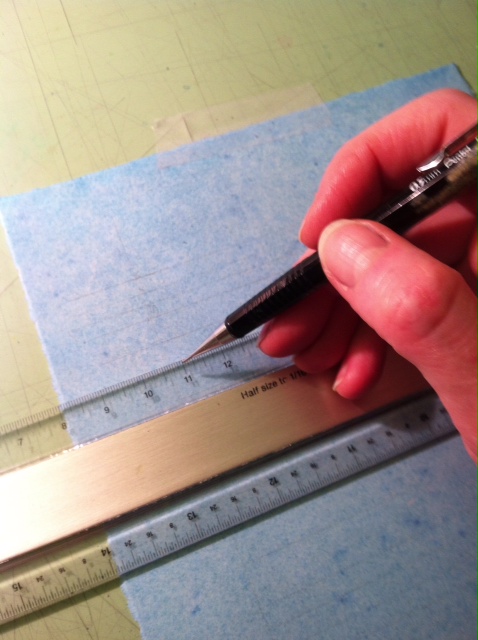
I squeezed some ink into my favorite inkwell (the bottom of a plastic wine glass — the perfect size and depth for a dip pen, and does not tip over!)…

And started writing:
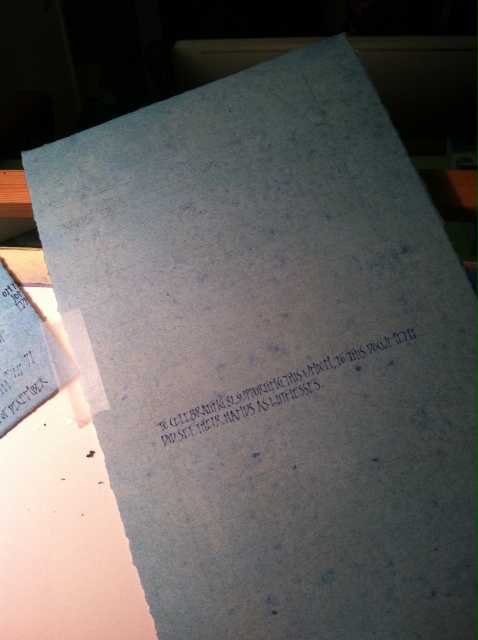
You may wonder why I started in the middle of the sheet, and not at the top.
Shhh!!! Calligraphers’ secret!
I’ve learned the hard way that it takes time to get into a rhythm, and I’m usually also kinda nervous when I start writing a big project like this. If I start at the top, with the first word of the document, it’s a sure bet that those first few letters are going to look really bad!
So instead, I start somewhere lower down the page. Then by the time I get to the top, I’m in my rhythm, the nerves are mostly worked out, and the start of the document will invariably turn out a whole lot better!
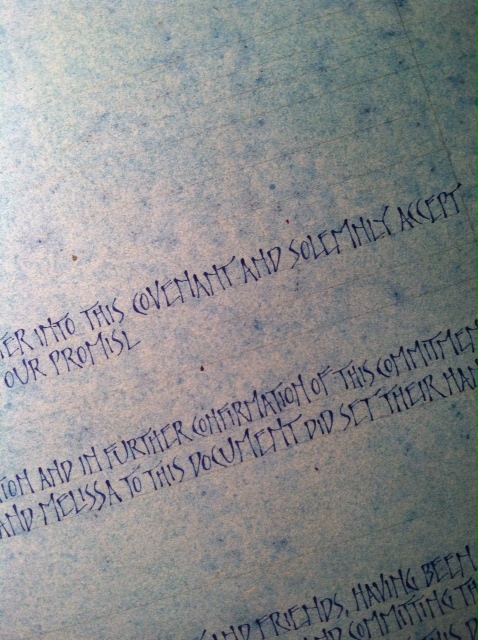
Another calligrapher’s trick: when you take a break — whether to go to the bathroom, get a cup of coffee, get some sleep for the night, or simply dip your pen into ink again — it’s best to stop not at the end of a line (as you’d think), but rather in the middle of line, ideally in the middle of a word, ideally in the middle of a letter.
Why?
Well, as I’ve mentioned, calligraphy is very much about rhythm. Each time you stop and start again, your rhythm will change just a little bit. If there’s a gap between those stops and starts, the eye will pick it up in a flash.
But if the stop/start is in the middle of a block of text, it’s less noticeable. Plus if you stop in the middle of a letter (as in the E at the end of promise above), you’ll have a stroke or two to get back into rhythm before leaping to the next word or line.
All was going quite smoothly, and I was happy with how the English was coming along, and then… DISASTER!
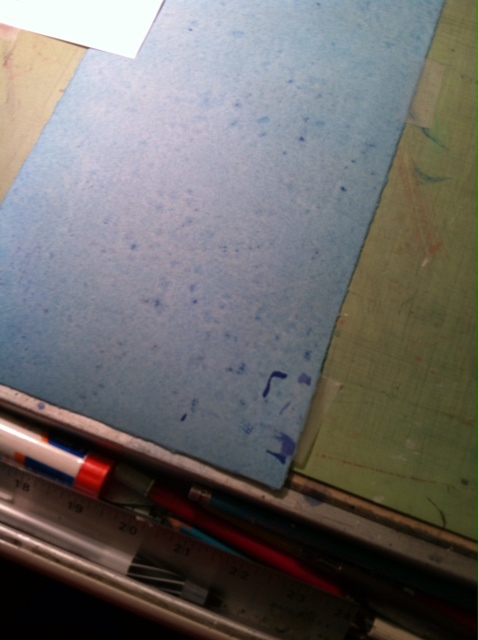
Somehow, without noticing, I’d managed to smear ink on the bottom of the paper! Oh, noooooooo!!!
If this were a piece for a client, I’d have started all over with a new sheet of paper, but there wasn’t time for that. Plus, the beauty of working in a spontaneous, modern, abstract style is that anything goes. I’d simply have to figure out a way to resolve this problem as I went along.
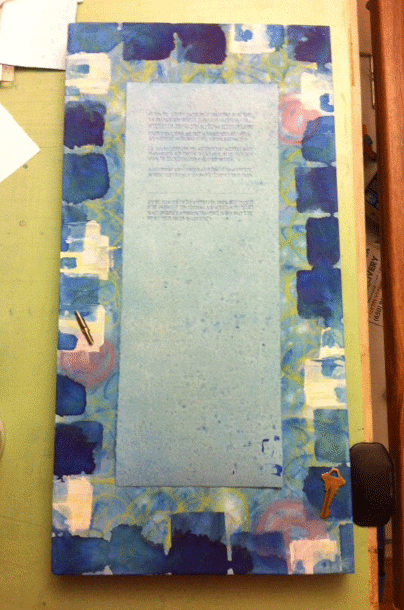
For now, I’d work on getting the Hebrew text done. I’d solve the ink smear issue later…
First, lettering tests, to determine the size pen to use. The top two rows below were done with a Mitchell 5, the bottom two rows with a Mitchell 6. (And the white paper in the back is the computer printout to that I used as a spacing guide and hand guard, so my hand — with all its skin oils — rested on the white paper, and not on the watercolor paper.)
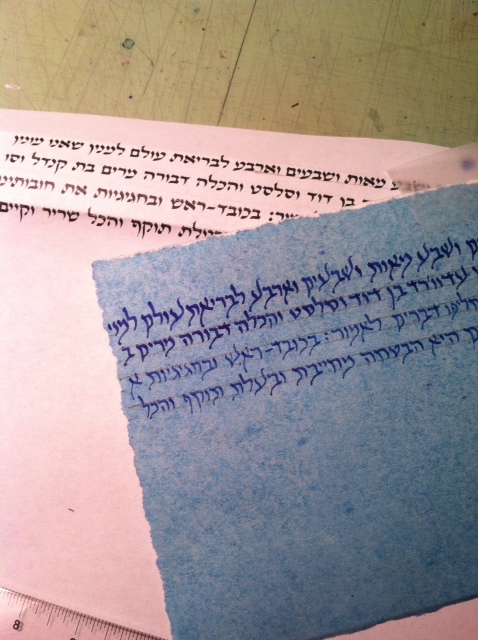
Next: lining up the paper for the Hebrew text:
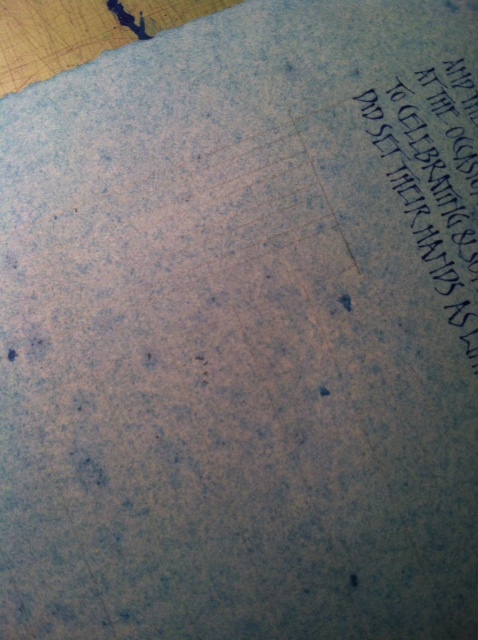
And here’s the completed text:
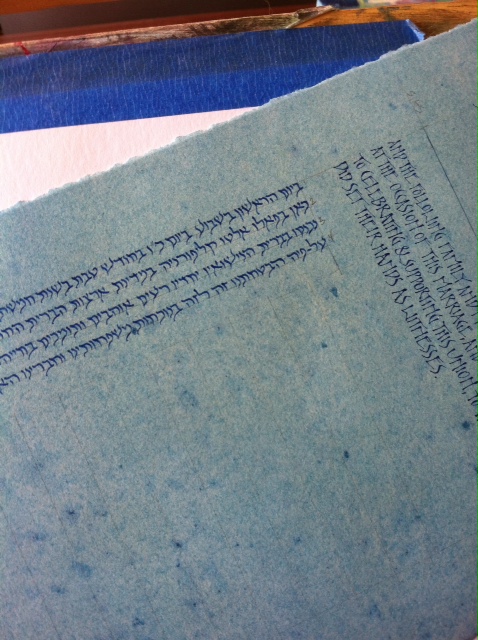
After inking in the signature lines and erasing the pencil lines, the text block was done!
But there was still that *$&#^ smear to deal with… (The key and pen nib on the canvas, btw, were possible design elements that I later nixed.)

My first thought was to add some more random-looking marks at the bottom of the text block. I even opened up a snapshot in Photoshop and played around to see how additional marks might look.
I didn’t like them. At. All.
Miracle Man suggested collaging over the marks, which I thought was a good idea. So I pulled out some silk fabric left over from when I created a Torah mantle for my synagogue, and started playing:

Missing something… How about this?

Hmm… Or this?
Or..?
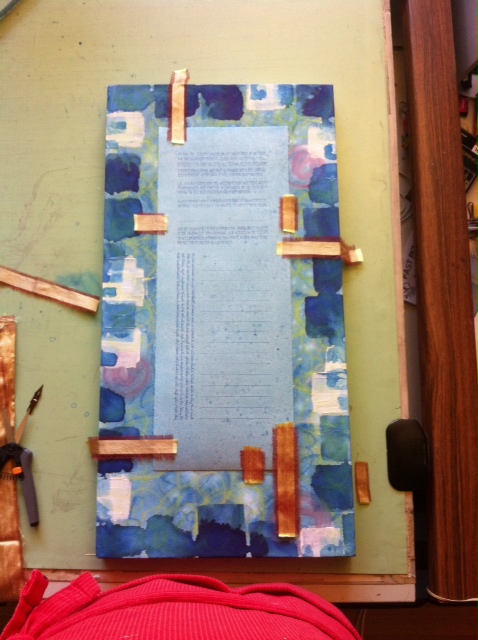
What was especially fun about this part was the reading the reactions from my followers when I posted these pics to Instagram & Facebook. (There were some strong opinions out there!)
I kind of liked what was happening with this gold silk… But I kind of didn’t. It really changed the color scheme I had going on.
So… What about collaging on some additional paper..?
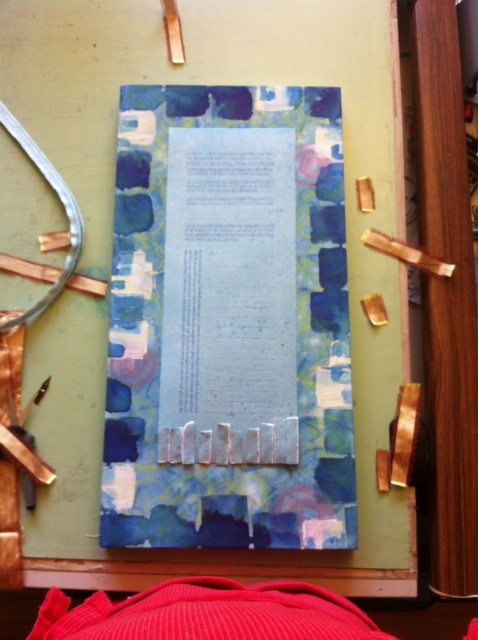
Again, VERY strong opinions on Facebook and Instagram. In both directions!
Then one more idea: adding some quilt swatches more in the color scheme of the ketubah:
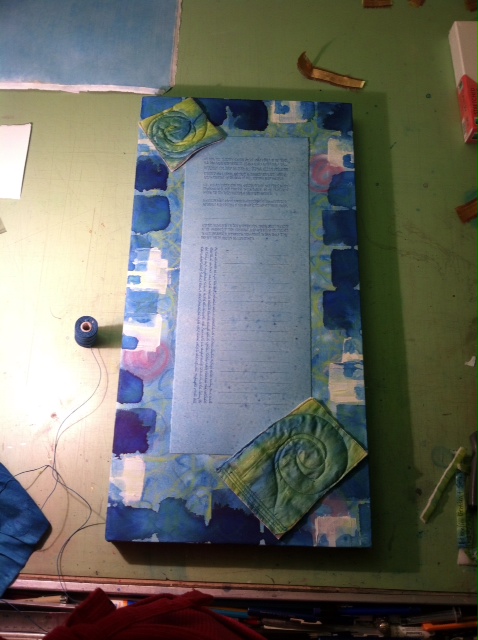
Or..
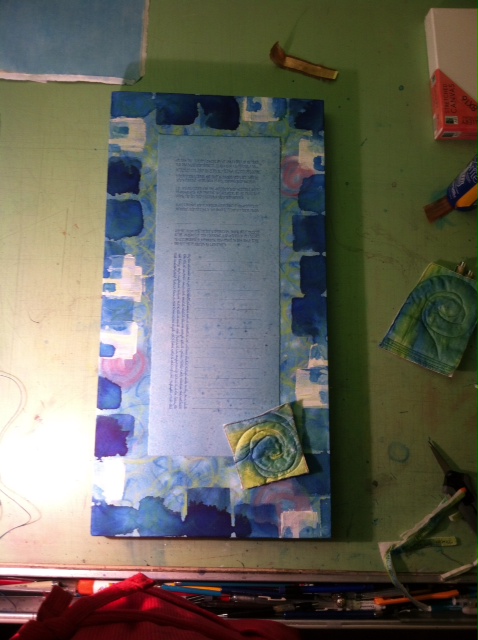
Ultimately, I wasn’t thrilled with any of these solutions. So while I let all these ideas stew, I decided to get on with attaching the text block to the canvas.
After consulting with a conservator I know, I decided to use a heat-activated adhesive film, Beva 371, to collage the paper down, before doing the stitching. (Note: I now wonder if perhaps I would have been better off just stitching the paper, without using any adhesive at all… Ah, well. It’s done.)
Here I am applying the film to the back of the text paper, using a tacking iron:
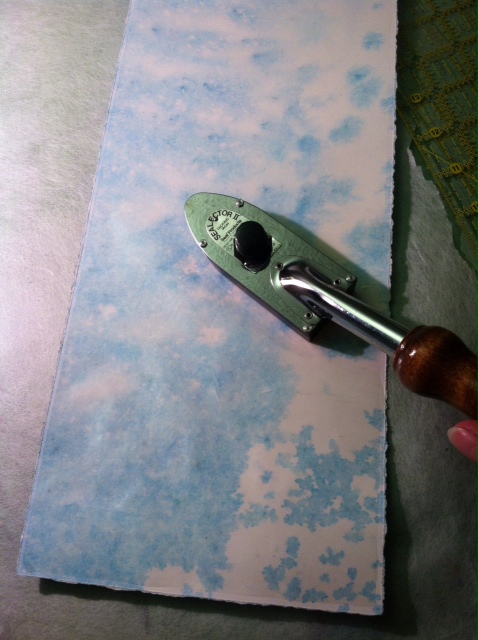
Then peeling off the silicone release Mylar off the film…
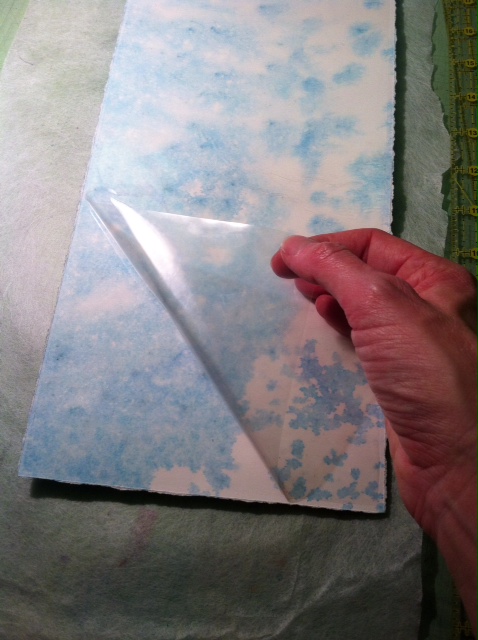
And now using the tacking iron to apply the text block to the canvas (covered with a piece of nonwoven material made for just this purpose, protecting the text block paper from being burnished by the iron):
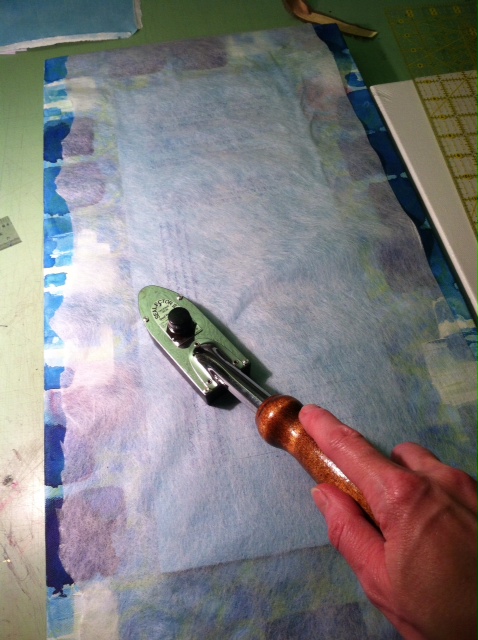
I then turned the canvas face down, and did a whole lot more ironing to get the adhesive to fully adhere, using a bone folder to smooth out any bubbles.
Here’s a badly squared-up snapshot of the collaged ketubah hanging on the wall (next to a small piece I finished earlier this year — yes, I seem to like blues and greens!):

Now for the stitching! This was the one thing I knew for sure I wanted to incorporate into this ketubah. I’ve wanted to sew a ketubah text onto a background for years, but have never had a client who liked this idea. Finally, I got to do it for myself!
There’s something so meditative about hand stitching. But this was also hard work: I used a thimble to push the needle into the paper and canvas, and a pair of needle nose pliers to pull the needle through the back side. (And I had fun making the stitches intentionally uneven, but not wildly so.)
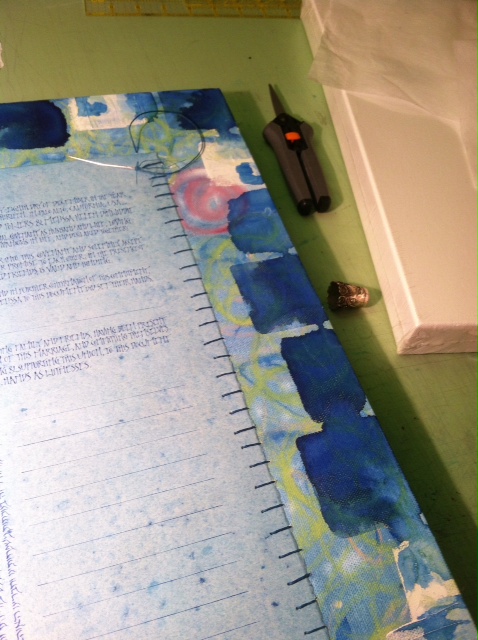
Here’s another shot of the ketubah with the first long side of stitching completed. At this point I also decided to apply clear granular gel over some of the darker squares around the perimeter. Those white spots will dry clear, just like Elmer’s Glue.
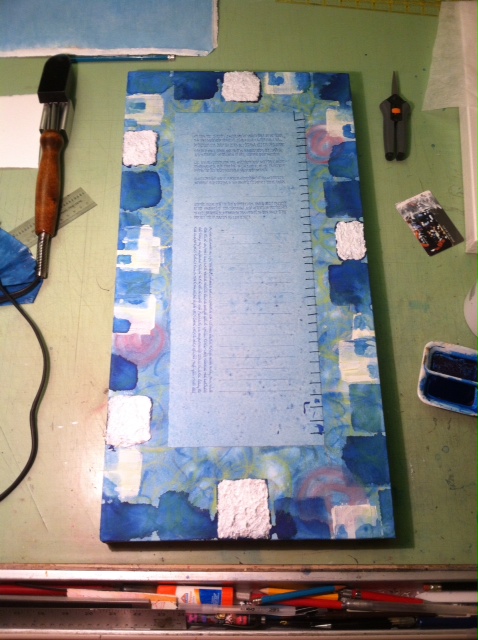
Stitching is fun, but can also get tedious. I needed a break. So I tore up the leftover background paper and calligraphed place cards for the post-wedding dinner, using a spontaneous lettering style I developed years ago, a sort of spiky, modern, informal Italic:
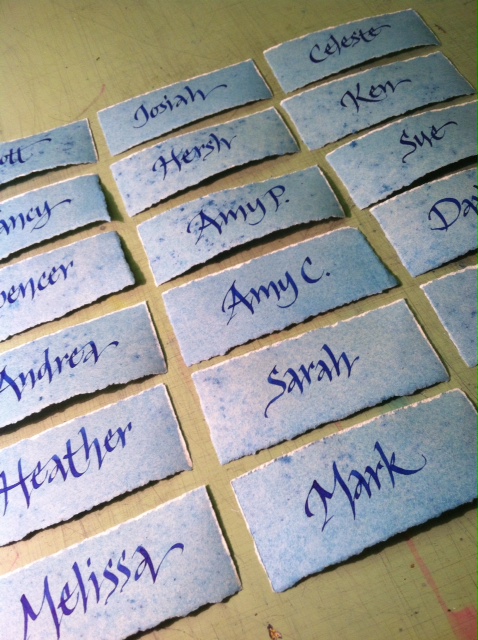
These I then pasted onto menus printed onto half sheets of card stock:
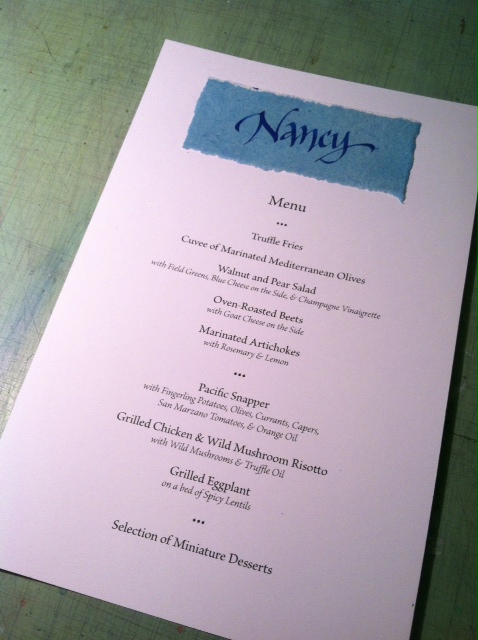
Did I mention this was mostly taking place from 4:00am to 8:00 two nights before the wedding, while I was horribly insomniac? Ahem. At least it was a productive night!
Here’s the back of the ketubah, more stitching done:
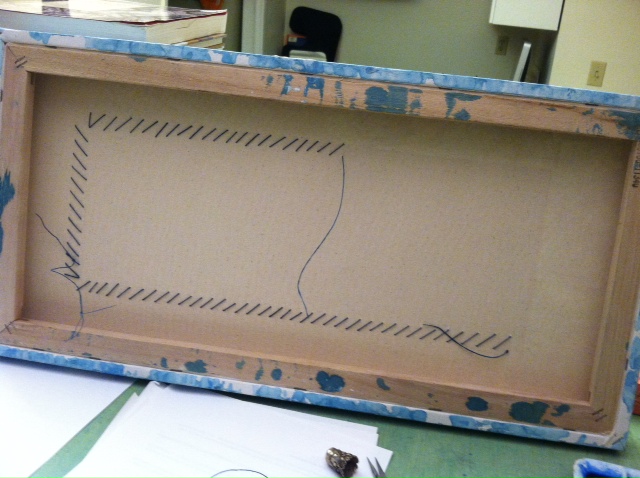
And the completed stitching! All that’s left to do is resolve that $*#@& smear…
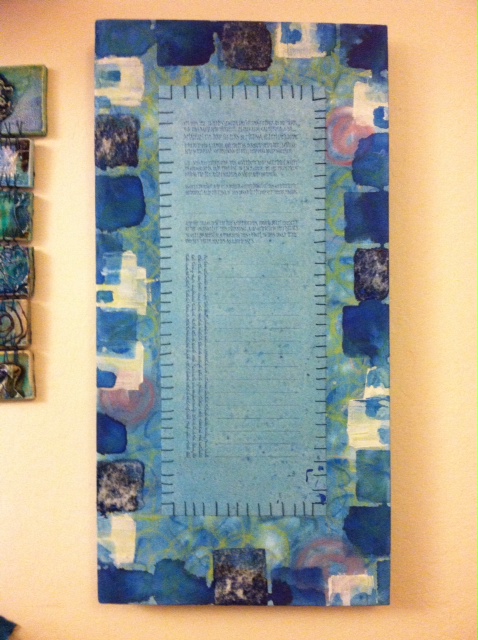
And add some “Yesses” into the artwork (which felt entirely appropriate, don’t you think?):
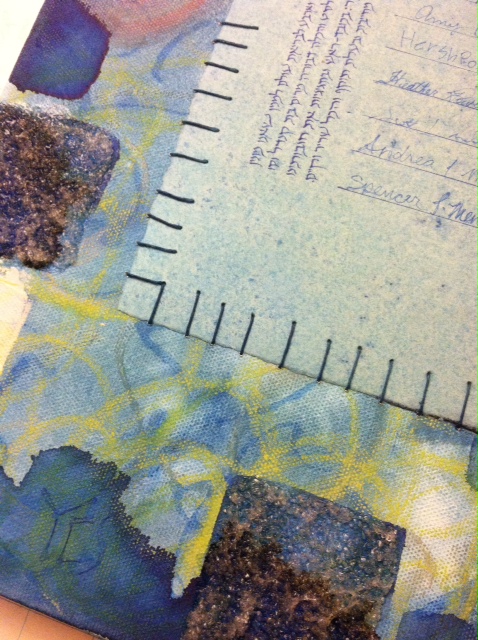
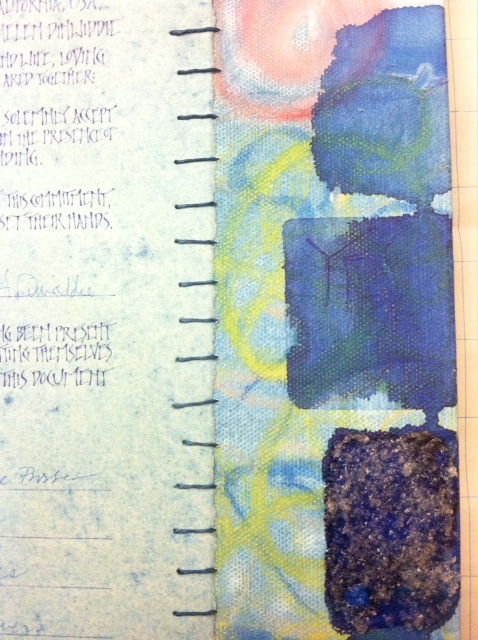
Don’t forget the sides of the canvas!

And here’s a peek at my ink smear solution:

And the finished, signed ketubah!
And my favorite photo from the signing ceremony on Saturday morning: my nephew “helping” his mom sign his name!
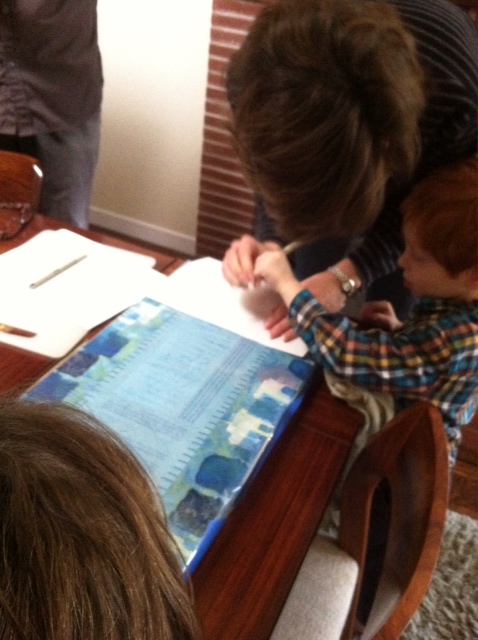
Our ketubah now hangs proudly just inside the door to our bedroom. I haven’t sealed it yet, but plan to do so with Golden acrylic matte spray varnish (and gloss varnish over the clear granular gel sections). But I’ll run tests on some smaller canvases before doing so. Always test and re-test before trying a new technique on a valuable piece!!!
Tomorrow morning we leave on a brief, “mini-honeymoon” (called so in hopes that a longer, more exotic destination may come later). Then it’s back to work, and back to creating!

PS — Pssst! Know someone who might benefit from seeing this today? Pass it on!
Ready to get sparked for 2014?
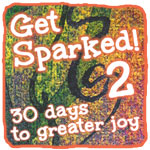 A deadline like a wedding will get me creating like nobody’s business! But what happens when there is no deadline?
A deadline like a wedding will get me creating like nobody’s business! But what happens when there is no deadline?
It’s all too easy to let life intervene, isn’t it?
It doesn’t have to be that way!
The solution? A safe, supportive tribe, reminding you that you are not alone. Gentle structure. Encouragement and reminders that yes, you deserve this! Yes, you need this!
Click here to join me for the next session of Get Sparked! starting on January 9th. It could change your life.

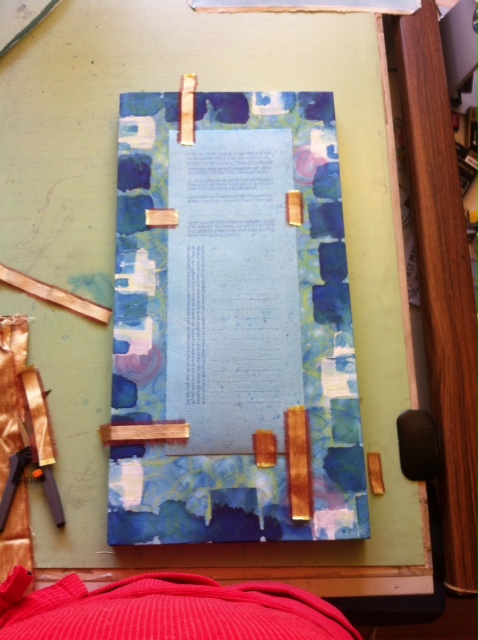
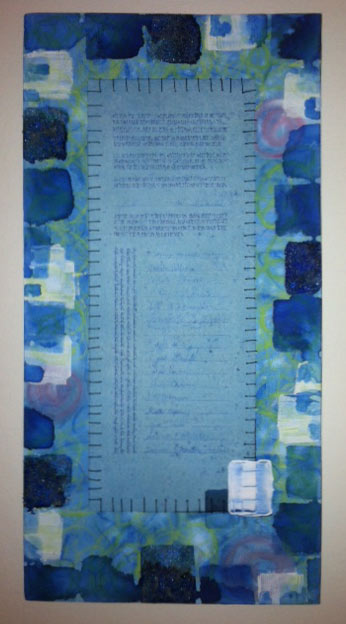
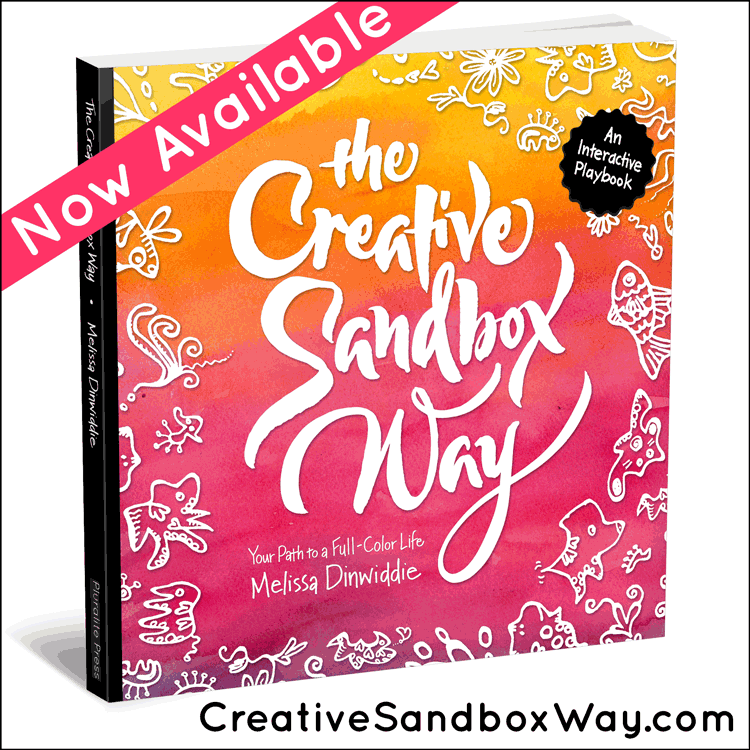
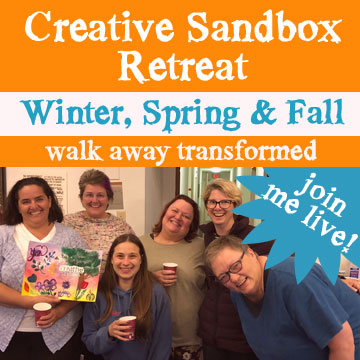
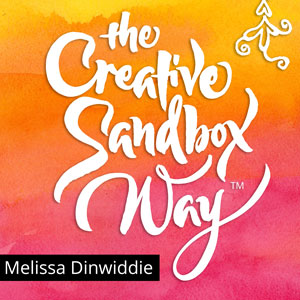

Leave a Reply